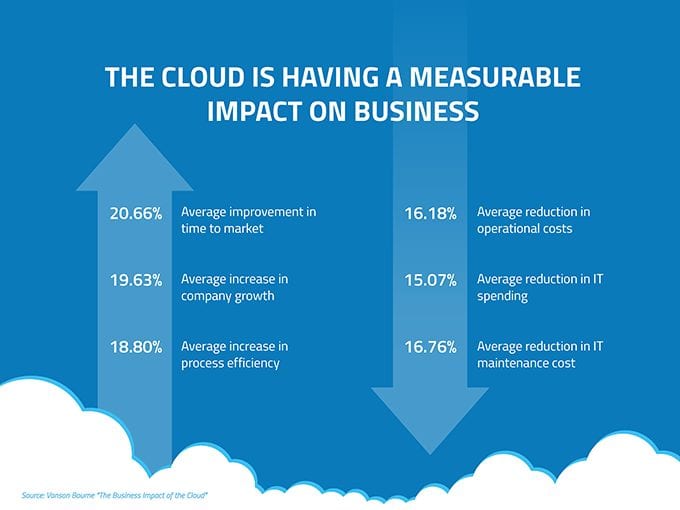
While the Cloud continues to be widely adopted by businesses around the world, there are still many misconceptions about what cloud computing costs. Some folks are concerned about moving to the cloud because they think it will be more expensive while others assume cloud computing is cheaper. What’s the truth?
As the Internet continues to pervade daily life, cloud computing is the newest online service that makes the most of Web connectivity. But what are the factors related to cost that you need to consider before adopting cloud computing?
The economic aspects of migration to cloud architecture
There are three different cloud delivery models that are based on pay-per-use billing. These include:
- Software as a Service (SaaS): A provider rents you different software applications that use cloud infrastructure which eliminates the need to install and run those applications on your own computer.
- Platform as a Service (PaaS): This is where you pay for an entire virtualized platform. PaaS is typically something developers buy to build applications.
- Infrastructure as a Service (IaaS): This is the delivery of computer infrastructure as a service, including servers, processing power and storage. This model eliminates upfront capital cost and is scalable.
The pay-per-use billing model is a payment method for cloud computing that charges based on usage. The practice is not unlike paying for your utility bills, paying only for the resources that you used. Companies find this model to be cost-effective because you only pay for the data you need and it’s customizable as well as scalable—it’s built to accommodate fluctuations and business growth.
But what other economic factors need to be considered before migrating to the cloud?
SMBs benefit from cloud computing
It’s worth noting that SMBs are uniquely positioned as ideal candidates for the adoption of cloud computing. There is no reason why they shouldn’t adopt the Cloud because there is no upfront capital investment in having to buy servers, there’s no need to rent out buildings and floor space to build data centers, there’s no need for electricity, cooling costs, no purchase of software licenses, etc. These companies are able to start small and grow exponentially with scalable cloud services that use the pay-as-you-go model. And statistically, the average SMB can benefit from a 36% cost savings by migrating to the cloud.
The challenge of computing ROI comes when making a decision for companies with an already existing and working datacenter (IT infrastructure). Is it a smart investment for an organization in this scenario to move to the cloud? Or is it financially smarter to stick with their own in-house infrastructure?
How to identify your company’s economic suitability for the Cloud
Cloud computing provides all kinds of neat technology and security features. However, everything comes at a cost and companies need to be wary of accruing cloud runaway costs that can occur after migration. That’s why it is critical for companies to first evaluate their existing resources prior to making the shift to cloud computing. If you have an accurate picture of what resources you’re using today, you can more accurately forecast cloud computing costs.
Size of your IT resources
How large are the resources already present in your company? Conducting an audit of your current IT infrastructure costs and the scale of your operations is imperative before deciding to move to the cloud. The audit will reveal what you’re currently paying to run IT over time and what your new cloud environment might look like.
Consider basic direct costs first. How much are you paying for your:
- Software and Hardware
- Physical servers
- Software licenses
- Maintenance contracts
- Warranties, supplies, materials, spare parts, etc.
- Network bandwidth
- Storage
- Database capacity
Operational costs to consider during an audit could include the cost for:
- Maintenance of servers, databases, and other technologies
- The facilities that house IT hardware
- Connectivity to the Internet
For companies with massive data centers (operating far more than 10,000 servers) it may not be economically viable to drop their own infrastructure entirely and head towards the Cloud. However, this isn’t the only yardstick for determining whether a company should abstain from cloud computing.
Workload Demand
Part of what makes the Cloud profitable depends on the amount of utilization of your existing IT resources. According to a study, “[a] large number of very underutilized (too much over provisioning) server resources leads to a large amount of wastage and hence makes it suitable for using cloud services, whereas small yet perennially well utilized servers would not be economical if taken to the clouds.” For example, some companies have workloads that run around the clock 24 hours a day while others must provision for more sporadic spikes in workloads. The latter can be especially relevant to businesses who rely on web applications where there are highly variable spikes in resource demand given on the hour, the day, the season.
The cloud is the most cost-effective solution for companies who have more variable workloads. That’s because the Cloud delivers highly scalable and dynamically allocated resources. A company can accommodate spikes in resource demand by simply renting out a virtual machine (VM) for an hour or two, paying for only the hours the VM was used, and then shutting it down. On the flip side though, if your company requires large consistent workloads all year long, there comes a point where it becomes less expensive for you to run that VM on your own internal hardware.
Amount of data handling
How much data is acted upon or generated in a day at your company? Huge amounts of data require a large bandwidth that would use a lot of data processing and storage. This factor can contribute to inflated cloud costs in a cloud computing model. However, looking at the associated costs of data usage may also lead to a discussion of how a company may be able to cleanup that data or reduce duplicate files. What’s more, the prevalence of large amounts of data processing may not necessarily mean that a company should never consider cloud computing. It’s just worth noting that if a company wants to control runaway cloud costs, they need to consider the amount of data handled.
Sensitivity of data
Data security is always a top concern when it comes to cloud computing. And it can contribute to unexpected costs in cloud computing as a result of idle resources, over-provisioning, maintenance mistakes, human error, or security breaches due to poor management of security services.
Major cloud providers like Microsoft are better equipped to help organizations remain compliant and avoid any additional security expenditures. These types of providers can be better suited to protecting a company’s data given that they can afford the overhead of armed guards, super redundant networking and power, and other security fail-safes that a single IT department cannot afford.
Quantifiable long-term cost benefits of cloud computing

As companies evaluate whether their business would financially benefit from switching to the Cloud, there are still other long-term cost benefits that should be considered. The market research company Vanson Bourne generated a report on the business impact of the cloud, highlighting a handful of cost advantages that empower companies to stay productive and profitable post adoption. So, while an organization may not immediately reap the benefits of cloud deployment, the long-term cost savings may prove to be a compelling reason for making the switch.
8 ways your business profits from cloud computing
1. Always up-to-date software
With SaaS being the most widely adopted cloud computing model, companies are getting the latest versions of the apps they depend on to run their business. Software enhancements are frequent, easy to implement, and protects against bugs or security vulnerabilities.
2. Doing more with less
Cloud computing helps companies reduce the size of their own data centers (or eliminate them completely). Reduce the number of servers, the software cost, and the number of IT staff as well as maintenance costs.
3. Always-on availability
Major cloud providers are extremely reliable in providing services with 99.99% uptime. That means the connection is always on and employees can access the applications they need when and where they need them.
4. Increased mobility
Employees are no longer tied to their physical office to work productively. With cloud computing, they can take their work with them and access the files they need from anywhere on any device. Rest assured that most major cloud providers like Microsoft also ensure the best security protocols are being executed to protect data at all times.
5. Flexible costs and capacity
As mentioned before, one of the greatest cost benefits of cloud computing is its flexibility. Companies only pay for the infrastructure and server capacity they need. This makes it cheaper for companies to accommodate peak times when more capacity is required at a given moment and then de-provision that capacity once it’s no longer required.
6. Improved collaboration
Cloud applications like Office 365 and Teams are examples of how Cloud computing is making it easier for organizations to stay productive. Employees are using SaaS apps to collaborate with their colleagues in real-time over virtual meetings, shared documents, and chat channels with instant access to business files and projects. This can reduce time-to-market and speed up product development and customer service.
7. Cost effective
Companies neither need to purchase equipment or build out and operate a data center. They don’t need to spend tons of money on hardware or other aspects of operations like renting out physical facilities or paying for utilities.
8. Improved business agility
Cloud computing increases a company’s agility and therefore ability to execute change faster. By running on the Cloud, it no longer needs to take years to migrate business applications and decommission data centers to accommodate the IT needs that arise from a merger or acquisition.
More research about cloud computing costs
According to a study conducted by the Cloud Security Alliance, 33% of organizations are fully adopting cloud services and 86% of companies spend at least part of their IT budget on cloud applications. But why should your company follow suite? For more information to help you discern whether your company should invest in cloud computing, contact TechWise Group today or dive deeper into a technical whitepaper that expounds further on a company’s suitability for the adoption of cloud computing.